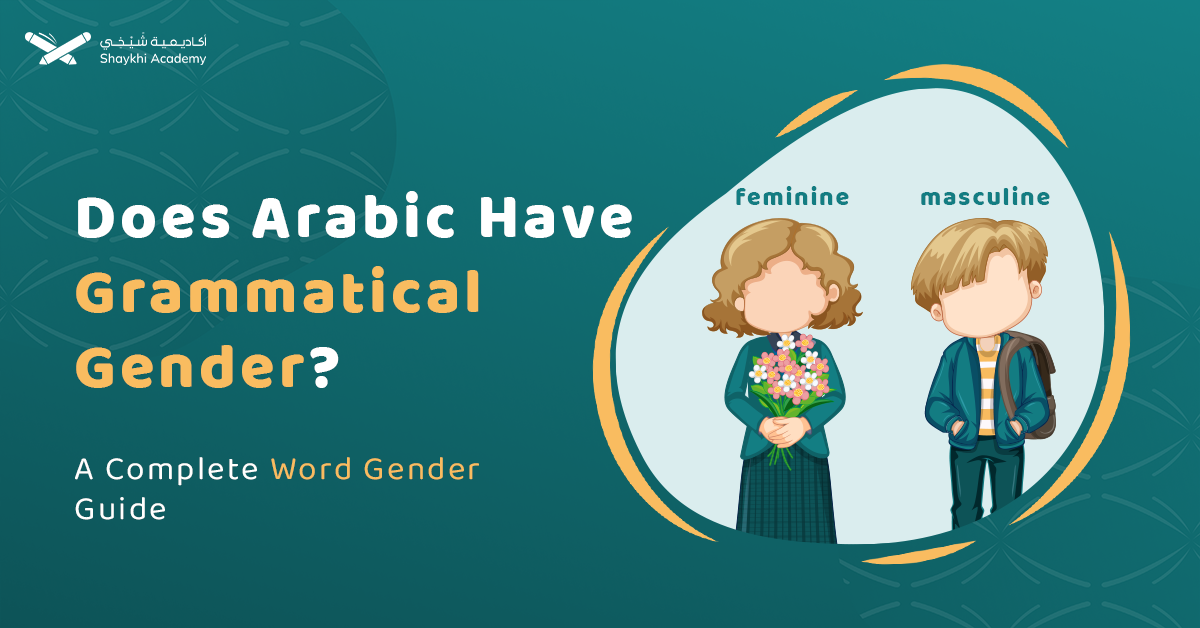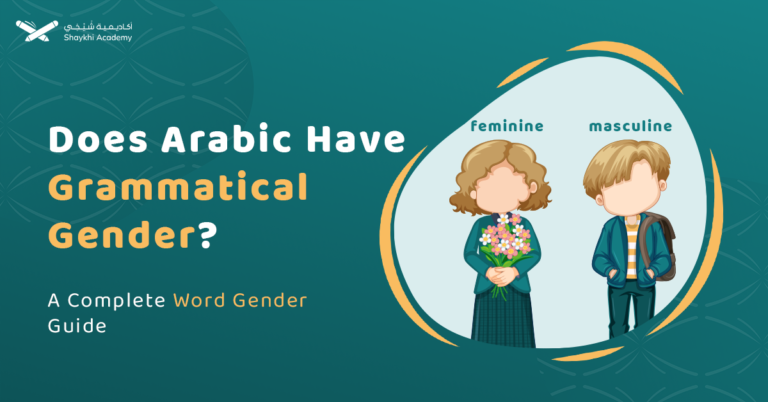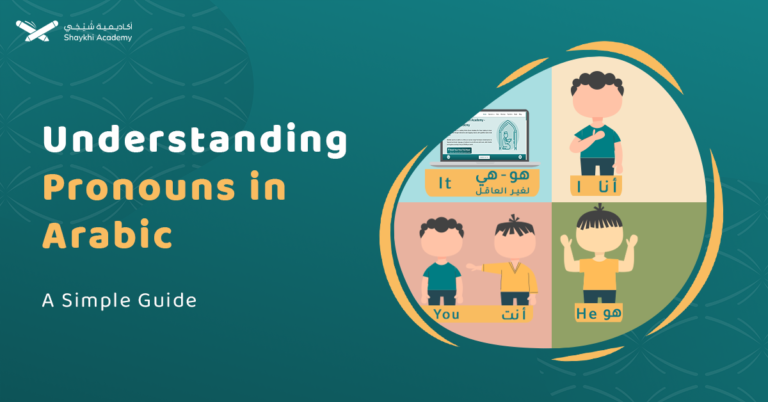Arabic differs from other languages because it has two grammatical genders, masculine and feminine. This affects different types of words, such as verbs and nouns, because they must follow the gender of the noun to which they are related.
In this article, we are going to discuss the two grammatical genders of Arabic, their types, how they affect verbs and adjectives, and what courses can help you understand more about Arabic and its grammatical genders.
Does Arabic Have Grammatical Gender?
Yes, Arabic does have grammatical gender. It has two main grammatical genders: masculine and feminine. These genders influence various elements of the language, including nouns, pronouns, verbs, and adjectives.
- Nouns: Masculine nouns typically have no marker, while feminine ones often end with “ة” (Taa’ Marbootah), like “كراسة” (notebook).
- Pronouns: Masculine pronouns (e.g., “هو” for “he”) and feminine pronouns (e.g., “هي” for “she”) exist.
- Verbs: Verbs agree with the gender of the subject, e.g., “يرسم” (he draws) for masculine, “ترسم” (she draws) for feminine.
- Adjectives: Adjectives must match the gender of the noun, e.g., “طويل” (tall) for a man, “جميلة” (beautiful) for a woman.
Grammatical gender affects sentence structure and communication in Arabic. Aned the rules of gender in Arabic is essential for constructing grammatically correct sentences and ensuring proper communication.
Types of Gender Rules in Arabic Grammar:
It’s important to learn about the different types of gender rules in Arabic grammar to understand how to make correct sentences to ease communication. The types of gender rules in Arabic grammar are:
1. Arabic Noun Gender Rules:
The rules for the Arabic noun gender mainly differ depending on whether the noun is masculine or feminine.
A. Masculine Nouns:
Most masculine nouns in Arabic don’t have a certain marker but they have certain patterns.
For Example, “كتاب” which means “Book” and is pronounced as “Ketab”, or “باب” which means “Door” and is pronounced as “Bab”.
B. Feminine Nouns:
Most feminine nouns are usually identified by “ة” which is called “Taa’ Marbootah” in Arabic and is pronounced as “H or T” at the end of a word.
For Example, “كراسة” which means “Notebook” and is pronounced as “Korrasah”, or “باب” which means “Door” and is pronounced as “Bab”.
It’s the most common sign, but it’s not the only one. We have another sign, which is “ى” which is called “Alif Maqsorah” in Arabic and is pronounced as “A” at the end of a word.
For Example, “ليلى” means a girl named “Laila” and is pronounced as “Laila”.
C. Some Irregularities:
Some irregularities exist, as some nouns don’t follow these rules and they also have their pattern.
For Example, “يد”, which means “Hand” and is pronounced as “Yadd”, is a feminine noun despite not ending with “ة” or “ى”.
Another Example, “مستشفى”, which means “Hospital” and is pronounced as “Mostashfa”, is a masculine noun despite ending with”ى”.
2. Arabic Pronoun Gender Rules:
You might wonder if there are gender-depending pronouns in the Arabic language. Of course, even pronouns in Arabic do have grammatical gender rules.
These pronoun gender rules differ whether they’re referring to a male or a female and also differ depending on the count whether it is for singular, dual, or plural.
A. Singular:
| Singular | |||
| Type | Pronoun | Meaning | Pronunciation |
| Personal pronouns | هو | He | Hwa |
| هي | She | Hya | |
| أنتَ | “You” for male | Anta | |
| أنتِ | “You” for female | Anti | |
| Near Demonstrative pronoun | هذا | “This” for male | Hatha |
| هذه | “This” for female | Hathehe | |
| Far Demonstrative pronoun | ذلك | “That” for male | Zalek |
| تلك | “That” for female | Telka | |
For Example, “هذا طالب” which means “This is a student” and is pronounced as “Hatha Taleb”, or “هذه طالبة” which means “This is a student” and pronounced as “Hathehe Talebah”.
B. Dual:
| Dual | |||
| Type | Pronoun | Meaning | Pronunciation |
| Personal pronouns | هما | “They” for both males and females | Homa |
| أنتما | “You” for both males and females | Antoma | |
| أنتِ | “You” for female | Anti | |
| Near Demonstrative pronoun | هذان | “These” for males | Hazaan |
| هاتان | “These” for females | Haataan | |
| Far Demonstrative pronoun | ذانك | “Those” for males | Zanek |
| تانك | “Those” for females | Tanek | |
For Example, “هذان طالبان” which means “These are two students” and pronounced as “Hazaan Taleban”, or “هاتان طالبتان” which means “These are two students” and pronounced as “Haataan Talebatan”.
C. Plural:
| Plural | |||
| Type | Pronoun | Meaning | Pronunciation |
| Personal pronouns | هم | “They” for males | Hom |
| هن | “They” for females | Honna | |
| أنتم | “You” for males | Antom | |
| أنتن | “You” for females | Anotonna | |
| Near Demonstrative pronoun | هؤلاء | “These” for both males and females | Ha’ula’ek |
| هاتان | “These” for females | Haataan | |
| Far Demonstrative pronoun | أولئك | “Those” for both males and females | Aula’ek |
| تانك | “Those” for females | Tanek | |
For Example, “هم أطباء” which means “They are doctors” and is pronounced as “Hom Ateba’a”, or “هن طبيبات” which means “They are doctors” and pronounced as “Honna Tabebat”.
3. Arabic Verb Gender Rules:
Arabic verb gender rules are different, As the verbs’ gender depends on their subject, which is a noun. So, if you are wondering whether verbs in Arabic have gender or not, they don’t. Their gender is based on their subject, and the rules differ from tense to tense.
A. In The Present Tense:
In the present tense, the rules of verb gender in singular are different from the rules of verb gender in plural as follows:
| Singular | masculine verbs start with the letter “يـ” which is pronounced as “Ya”, and feminine verbs start with the letter “تـ” which is pronounced as “Ta” | Masculine | “يرسم” means “he is drawing” and is pronounced as “Yarsum” |
| Feminine | “ترسم” means “she is drawing” and is pronounced as “Tarsum” | ||
| Plural | The same as singular verbs in addition to adding “ون” (Oun) at the end of masculine verbs and “ن” (Noon) at the end of feminine verbs | Masculine | “يرسمون” means “They are drawing” and is pronounced as “Yarsumoun” |
| Feminine | “ترسمن” means “They are drawing” and is pronounced as “Tarsumna” |
B. In The Past Tense:
In the past tense, the rules of verb gender in singular are different from the rules of verb gender in plural as follows:
| Singular | To convert masculine verbs into feminine verbs you should add the letter “تـ” (Taa’) at the end of the verb. | Masculine | “رسم” means “he drew” and is pronounced as “Rasam” |
| Feminine | “رسمت” means “she drew” and is pronounced as “Rasamat” | ||
| Plural | Masculine verbs end with the letters “و+ا” (Waw+Alif), and feminine verbs end with the letter “ن” (Noon) | Masculine | “رسموا” means “they drew” and pronounced as “Rasamou” |
| Feminine | “رسمن” means “they drew” and is pronounced as “Rasamna” |
C. The Imperative:
In the imperative, the rules of verb gender in singular are different from the rules of verb gender in plural as follows:
| Singular | To convert masculine verbs into feminine verbs you should add the letter “ي” (Yaa’) at the end of the verb. | Masculine | “ارسم” means “Draw!” and is pronounced as “Ersum” |
| Feminine | “ارسمي” means “Draw!” and pronounced as “Ersumy” | ||
| Plural | Masculine verbs end with the letters “و+ا” (Waw+Alif), and feminine verbs end with the letter “ن” (Noon) | Masculine | “ارسموا” means “Draw!” and pronounced as “Erasumou” |
| Feminine | “ارسمن” means “Draw!” and is pronounced as “Ersumna” |
4. Arabic Propositions Gender Rules:
Arabic propositions are not affected by the gender of the nouns they refer to, they are neutral, as they only act as connectors in the sentence and they don’t affect the grammatical gender of other words in the phrase.
You can get to know more information about grammatical gender in the Arabic language by joining the Arabic Grammar Course with native Arabic tutors at Shaykhi Academy.
You can also learn more about grammatical rules in Arabic by joining the Intensive Arabic Course Online from Shaykhi Academy.

Book your free trial now!
Gender Adjectives in Arabic:
In Arabic, Adjectives Gender follows the noun they are describing, and they also must agree with the noun in number. So, adjectives are divided into masculine adjectives, feminine adjectives, and irregularities.
1. Masculine Adjectives:
Masculine adjectives are used with masculine nouns, but they don’t have a specific rule or suffix in singular, but in dual or plural, they tend to end with specific letters.
In dual, Masculine adjectives typically end with the letters “ان” (An). In the plural, they typically end with the letters “ون” (Oun)
| Example | Meaning | Pronunciation | The noun | The adjective | |
| Singular | رجل طويل | A tall man | Rajul Taweel | رجل (Rajul) | طويل (Taweel) |
| Dual | رجلان طويلان | Two tall men | Rajulan Taweelan | رجلان (Rajulan) | طويلان (Taweelan) |
| Plural | رجال جيدون | Good men | Rejal Jayedoun | رجال (Rejal) | جيدون (Jayedoun) |
2. Feminine Adjectives:
Feminine adjectives are used with feminine nouns. In singular, they typically end with “ة” (Taa’ Marbootah). In dual, they typically end with the letters “ان” (An) just as the masculine ones. In the plural, They typically end with the letters “ات” (At).
| Example | Meaning | Pronunciation | The noun | The adjective | |
| Singular | فتاة جميلة | A beautiful girl | Fatat Jameela | فتاة (Fatat) | جميلة (Jameela) |
| Dual | فتاتان جميلتان | Two beautiful girls | Fatatan Jameelatan | فتاتان (Fatatan) | جميلتان (Jameelatan) |
| Plural | فتيات جميلات | Beautiful women | Fatayat Jamilat | فتيات (Fatayat) | جميلات (Fatayat) |
3. Irregular Adjectives:
Some adjectives don’t follow the noun in grammatical gender, as they don’t change between masculine and feminine, or they don’t have the same suffix as the typical adjectives as in plural masculine adjectives.
| Example | Meaning | Pronunciation | The noun | The adjective | |
| Masculine | الرجل الطويل | The tall man | Al-rajul al-taweel | الرجل (Al-rajul) | الطويل (Al-taweel) |
| Feminine | المرأة الطويل | The tall Woman | Al-mara’ah al-taweel | المرأة (Al-mara’ah) | الطويل (Al-taweel) |
| Masculine | رجال طوال | Tall men | Rejal Tewal | رجال (Rejal) | طوال (Tewal) |
What Are the Gender Forms in Arabic?
Grammatical gender in the Arabic language mainly is divided into two gender forms: masculine form and feminine form.
1. Masculine Gender Form:
Masculine gender form refers to any male object or creature whether it is a human being or an animal.
For example, “رجل” which means “a man” and is pronounced as “Rajul”, and “كتاب” which means “a book” and is pronounced as “ketab”
2. Feminine Gender Form:
Feminine gender form refers to any female object or creature whether it is a human being or animal, and it ends usually with “ة” (Taa’ Marbootah) unless it’s irregular.
For example, “أرض” which means “Earth” and is pronounced as “Ard”, and “فتاة” which means “a girl” and is pronounced as “Fatat”
How to Know If an Arabic Word Is Male or Female?
The most common method to know whether the Arabic word is for a male or a female is the “ة”, which is called “Taa’ Marbootah” in Arabic and is pronounced as “H or T” at the end of a word. If a word ends with “ة” then it is most likely feminine.
For example, “لطيف”, which means “nice” for male, is pronounced as “Latif”, it turns to “لطيفة”, which means “nice” for female and is pronounced as “Latifah”.
You can always figure out the gender of the word if you look for the known suffix of each gender as mentioned before in the previous discussion.

Book your free trial now!
Learn Arabic Grammar Course with Native Arabic Tutors at Shaykhi Academy:
You can enjoy learning a lot about the Arabic language in a short time by joining the Arabic Grammar Course with Shaykhi Academy. Our native Arabic tutors will help you enhance your knowledge about Arabic grammar to be proficient including Arabic nouns and verbs and their grammatical gender.
Joining this course makes you more familiar with Arabic culture and you can make complete sentences with correct grammar rules. It also allows you to use the suitable form of verbs and nouns to match in gender and number.
In this course, you get your special curriculum according to your level and skills, you can take it from home or anywhere you want, and this also comes with affordable prices.
Why Shaykhi Academy?
- Expert Native Tutors: Learn from highly qualified native Arabic speakers.
- Flexible Scheduling: Tailor your classes to fit your busy life.
- Affordable Learning: Access top-quality education at a price that suits you.
- Global Access: Study from anywhere in the world.
Explore Our Arabic Courses:
- Noorani Qaida: Build a strong foundation in Quranic Arabic.
- Comprehensive Arabic Courses: Master the Arabic language, from beginner to advanced levels.
- Fusha Arabic Classes: Delve into Modern Standard Arabic, the key to understanding literature, media, and formal communication across the Arab world.
- Quranic Arabic Course: Enhance your connection with the Quran by learning the language in which it was revealed.
Start Your Arabic Journey Today! Whether you’re just starting or looking to deepen your knowledge, Shaykhi Academy is here to support your journey. Book your free trial now and begin your path to Arabic mastery!
In Conclusion:
Gender in the Arabic language is an essential rule that affects multiple words in sentences including verbs and adjectives. However, there are some exceptions to the rules of the word gender in Arabic.
Grammatical gender in Arabic is divided into masculine and feminine. Nouns have their grammatical gender, and it’s important to note that the verb itself does not have a grammatical gender in Arabic, but it follows its subject.
Adjectives follow the noun they describe in gender and number, And propositions are gender-neutral. You must learn these rules and their exceptions for better communication and understanding of the Arabic language.
You can convert most masculine nouns, including names of animals or names of jobs, into feminine nouns by just adding “ة” “Taa’ Marbootah”, and that applies to adjectives as well.
For example, “كاتب”, which means “A writer” for male, is pronounced as “Katib”, it turns to “كاتبة”, which means “A writer” for female and is pronounced as “Katibah”.
If you need any help, don’t hesitate to call us as soon as you can!













































